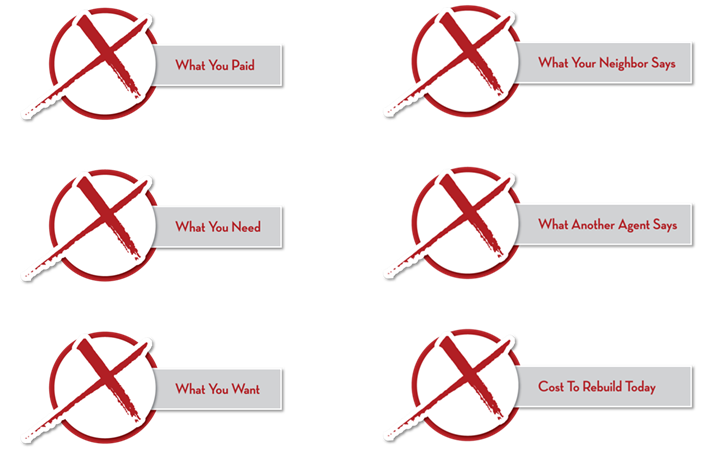
10 Reasons Why Your Condo Didn't Sell
- Price
- What you paid
- What you need
- What you want
- What your neighbor says
- What another agent says
- Cost to rebuild today
The obvious reason is price, but it’s how the price was set, whether the market conditions were considered and whether adjustments were made are what counts. Setting the right price is part art and part science. However, what doesn’t matter when sitting the initial price are:
The first three can be hard to take for some sellers, especially what a seller paid for their home. I always like to use a stock market analogy. If you owned Tesla stock and wanted to sell it today, would it matter if you bought it for $261/share on Dec 27th or $142/share on Apr 22nd? No. If you wanted to sell it today, you would get today’s price, which is around $192/share. Although not as liquid, real estate markets work the same way.
It is not always easy to set the right price in a shifting market and where you can’t control the competition. So, it is important to be able to adjust accordingly.

- Poor quality listing photos
- Unmotivated Seller
- Slow Response and Lack of Follow-up by the Agent
- Poor presentation
- Lack of Exposure
- Shifting Market
- Condition
- Location
- Hard to show
Poor photos and/or lack of a virtual tour are a must in today’s virtually connected world. The first impression a buyer is going to have is via the online photos. If an agent tries to do a photoshoot on their iPhone because they are too cheap to pay for a professional, they are doing a real disservice to their client.
In today’s digital age, high-quality photos and virtual tours are essential for attracting buyers. The first impression is often formed online, and poor-quality smartphone photos can be a real turn off to potential buyers. Professional photography highlights the condo’s best features, creating a compelling visual narrative. Pros also have wide-angle lenses to capture the entire room. In addition, a virtual tour allows buyers to explore the property remotely, increasing engagement. Skimping on these tools can significantly reduce a listing's appeal, ultimately doing a disservice to the seller.
Sellers who are unmotivated or inflexible can drive potential buyers away. If sellers are unwilling to negotiate or are difficult to work with, it creates a barrier for buyers who are looking for a smooth transaction. This lack of motivation can be seen in various ways, such as refusing to make necessary repairs, not accommodating showing schedules, or being unwilling to negotiate on price. Buyers prefer cooperative sellers, and any signs of reluctance or rigidity can lead them to choose other listings instead
Deals have a certain lifetime to them. If you take too long to respond, the buyer’s interest will begin to wane. They might feel like their offer is being "shopped around." Prompt and consistent communication is crucial in maintaining buyer interest and trust. When agents delay their responses, it can create a perception of unprofessionalism and disinterest, leading buyers to look elsewhere. In a competitive market, timely follow-up can be the difference between closing a deal and losing a potential buyer. Ensuring quick and effective communication reassures buyers that their offer is being considered seriously and helps to foster a smoother transaction process.
Following up with the buyer or buyer's agent is crucial. Buyers might have specific deal breakers, such as a particular settlement date, that they didn't initially mention but could be negotiated. Consistent follow-up allows listing agents to gather feedback from showings and identify what might be deterring potential buyers. This insight can lead to actionable changes, such as adjusting terms or making minor property improvements, to eliminate barriers and increase the property's appeal. Proactive communication demonstrates professionalism and a commitment to meeting buyer needs, often making the difference in closing a sale.
Photos out of order, lack of captions, inadequate or poor-quality photos, and a lack of virtual tours can fail to attract potential buyers. If the photos in the MLS listing don’t follow a logical order or tell a coherent story of the property, potential buyers may find it difficult to visualize the space. Additionally, a bland or uninformative property description can fail to highlight the condo’s unique features and benefits, losing buyer interest. An agent who doesn’t know the building and fails to point out the amenities further diminishes the property's appeal. Effective listing descriptions and well-organized, high-quality photos are essential to showcasing the property’s best features and maintaining buyer interest.
You can have great photos in the right order with captions and have it priced right, but if no one knows about it, the place still won’t sell. Effective exposure is critical in the real estate market. This involves leveraging various marketing channels, such as online listings, social media, email campaigns, and open houses, to reach a broader audience. Utilizing high-traffic real estate websites, engaging in targeted advertising, and ensuring the property is featured in MLS listings can significantly increase visibility. Additionally, word-of-mouth marketing and networking with other realtors can further enhance exposure. Without these efforts, even the most well-presented and competitively priced property can languish unsold due to a lack of buyer awareness.
Markets can change quickly. A slow real estate market or increased competition from other listings can impact the sale of a condo. When the market slows down, fewer buyers are actively looking for properties, which can result in longer listing times and potentially lower offers. This can be due to various factors, including economic uncertainty, higher interest rates, or seasonal trends. On the other hand, increased competition from other listings can make it challenging for a condo to stand out. Sellers may need to offer incentives, such as paying for closing costs or reducing the asking price, to attract buyers. Understanding these market dynamics and adjusting accordingly is crucial for selling a condo in a competitive environment.
If the condo requires significant repairs or updates, buyers might be discouraged, preferring move-in ready properties instead. Obvious problems like outdated fixtures, visible damage, or needed repairs can turn off buyers who prefer properties that are ready to occupy without additional investment. Buyers are often looking for convenience and want to avoid the hassle and cost of renovations. Additionally, visible issues may raise concerns about potential hidden problems, making buyers wary of purchasing a property that could require more extensive repairs than initially apparent. To attract more buyers, it’s often beneficial for sellers to address key repairs and updates before listing the property. This could include fixing broken windows, updating old appliances, and ensuring that all systems (plumbing, electrical, HVAC) are in good working order. Investing in these improvements can make the condo more appealing and can potentially lead to a quicker sale at a better price.
Location, location, location is a real estate maxim. When it comes to condos though, it means more than just the street address. The location within the building can make a big difference. The exact positioning within a building can influence factors such as natural light, noise levels, and ease of access. For instance, units on higher floors may offer better views and reduced street noise, while those closer to elevators and common areas may provide convenience but could also experience higher foot traffic and noise. Sometimes, a one floor difference can be the difference between looking into the back of another building versus a million dollar view of the monuments. Additionally, the orientation of a unit can affect its energy efficiency and comfort; south-facing units may benefit from more sunlight and warmth, which can be appealing in colder climates. Conversely, north-facing units might stay cooler during hot months. Therefore, when evaluating a property, it's essential to consider not only its address but also its specific location within the building to ensure it meets the buyer’s lifestyle and preferences.
Even if the photos are top-notch and the price is spot on, if you make it hard to show the place, you're going to miss out. Rental properties with tenants who don’t cooperate are often the biggest culprits. Limited showing times can frustrate potential buyers and their agents, making them skip your property altogether. Buyers usually have tight schedules, and if they can't see the condo when it's convenient for them, they'll move on to something else. To get more eyes on your listing, be flexible and make it easy for people to view the property. This might mean working with tenants or setting up automated showing systems. Without this, even the best listings can struggle to get attention.



